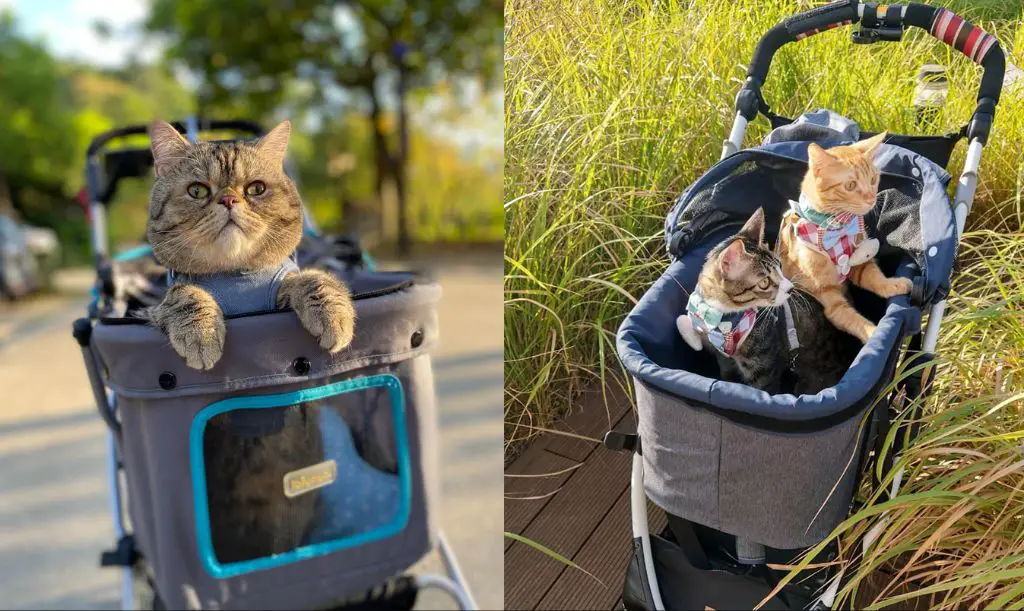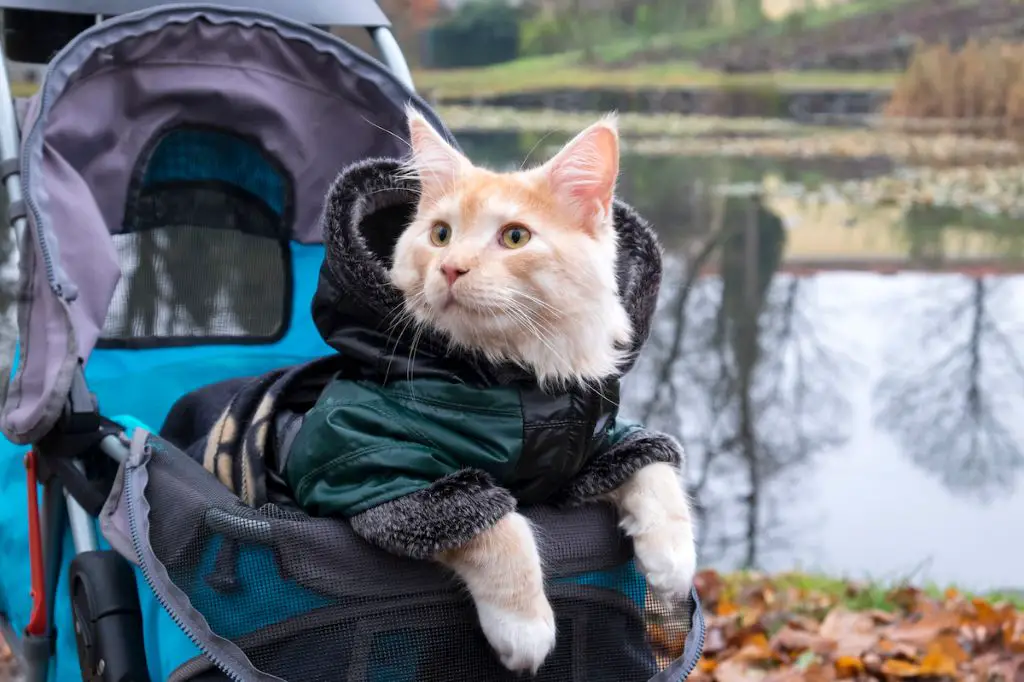Taking your cat outside for some fresh air and adventure can be a great way to enrich their life. However, some cats aren’t leash-trained and most prefer not to walk on a harness. This is where cat strollers come in handy! Cat strollers allow owners to take their feline friends on outdoor excursions while keeping them safe and secure. But are cat strollers really a good idea? Let’s take a closer look at the pros, cons, and things to consider.
What Are Cat Strollers?
Cat strollers are exactly what they sound like – strollers designed specifically for cats. They are enclosed, portable containers on wheels that allow pet owners to take their cats outdoors while keeping them safe and secure.
Cat strollers function much like baby strollers, with a fully enclosed compartment that the cat rides inside. They typically have mesh panels or windows so the cat can see outside. Most cat strollers have wheels for easy mobility, as well as brakes to keep the stroller in place when stopped. Many also have trays or attachments to hold food, water, and toys.
While cat strollers look similar to carriers, they allow cats to take in sights, sounds, and smells during an outing without the need to be leashed or harnessed. They provide enrichment while keeping cats enclosed and preventing escape.
Pros of Cat Strollers
One of the biggest pros of cat strollers is that they allow cats to safely experience the outdoors. According to https://catexplorer.co/stories-posts/all-about-cat-strollers, cat strollers function as a “safe space” for cats when taking them exploring outdoors. For cats that cannot be leash-trained or are unable to walk far distances, a stroller enables them to get fresh air and change of scenery while remaining secure inside.

Cat strollers also allow pet owners to take their cats more places with them. As noted in https://animalwellnessmagazine.com/cat-stroller/, strollers make it easy to bring cats along on trips to the park, outdoor cafes, or anywhere pet owners go. Whereas it might not be feasible to walk a cat on a leash everywhere, a stroller keeps the cat enclosed and provides a mobile means of bringing them along.
Overall, cat strollers enable safe outdoor experiences for cats that would otherwise be confined indoors. They allow pet owners to include their cats on more outings and provide environmental enrichment.
Cons of Cat Strollers
While cat strollers can be a fun way to take your feline friend outdoors, there are some potential downsides to consider as well. One of the biggest cons is that riding in a stroller can be stressful or overwhelming for some cats, especially if they are not properly introduced and trained to use it (Catexplorer). Cats are often wary of new experiences and enclosed spaces, so forcing a stroller on a cat before proper acclimation could create unnecessary anxiety.
According to pet experts, some signs of stress in cats when using a stroller may include panting, ears back, tail thrashing, trying to escape, yowling or other vocalizations (Meowa). Forcing an unwilling cat into a stroller could make the experience traumatic rather than enriching. It’s important to introduce any kind of carrier or transportation method slowly, providing treats and positive reinforcement. If a cat continues to show signs of distress in a stroller, it may not be the right option for that particular pet.
With patience and proper training, most cats can become comfortable with stroller rides. But for some felines, the confinement triggers too much stress and anxiety to make it an enjoyable experience. Knowing your cat’s personality and tolerances can help determine if a stroller may cause more harm than good.
Are Cat Strollers Safe?
There are some potential risks to consider when using a cat stroller, but these can be mitigated with proper precautions. According to CatExplorer, while very rare, accidents and injuries can occur if cats jump out of strollers or strollers tip over. To prevent this, choose a well-designed stroller with proper harnesses or enclosures. Do not leave your cat unattended in a stroller. Go slowly over bumps and uneven ground. Avoid busy areas with lots of activity that could spook your cat. Stick to flat, even paths and surfaces when first acclimating your cat to the stroller.
There are also risks associated with escapes if your cat manages to get out of the stroller. According to Paw Tracks, strollers should have a sturdy build and latching doors to prevent escapes. Only supervised outdoor time in the stroller is recommended. Keep an eye on your cat at all times and do not rely solely on the stroller’s restraints.
With proper precautions, cat parents can mitigate the potential risks. Using a well-designed stroller intended for cats, maintaining supervision at all times, going at a slow and steady pace, and acclimating cats slowly can make stroller rides safe and enjoyable.

Types of Cat Strollers
There are several main types of cat strollers to choose from:
Enclosed Cat Strollers
Enclosed cat strollers have a fully enclosed design with mesh windows or panels. They provide more security and protection for cats but can get warm. Some examples include the Frisco Pop-Open Cat Stroller and Pet Gear Happy Trails No-Zip Stroller.
Open Cat Strollers
Open cat strollers have an open design and allow for more airflow. However, they don’t provide as much containment for cats. The Paws & Pals City Walk N’ Stroll Pet Stroller is an example.
Jogging Cat Strollers
Jogging cat strollers have larger wheels and adjustable handles for jogging or running while pushing the stroller. The Dexas Popware Happy Trails Pet Stroller is designed for joggers.
Multi-Pet Strollers
Some strollers are designed to hold two or more pets. The Ibiyaya 5-in-1 Pet Carrier can hold up to 70 lbs of pets.
Choosing the Right Stroller
Choosing the right sized stroller for your cat is crucial for their comfort and safety. The stroller should be spacious enough for your cat to stand up, turn around, and lie down comfortably. Measure your cat from nose to rump while they are in a standing position to determine the interior height your stroller needs. Add a few more inches for extra wiggle room.

Look for strollers with features like a padded or plush bottom, built-in leash attachment, extendable sunshade, storage basket or pockets, swivel or locking front wheel, adjustable handles, and mesh ventilation panels. Consider your cat’s personality – nervous cats may prefer an enclosed carrier-style stroller while adventurous cats will appreciate open-air models. Strollers with detachable carrier bags offer versatility.
When in doubt, choose a stroller on the bigger side. Large strollers allow your cat to move around while small strollers can make your cat feel cramped. Prioritize comfort over portability so your cat enjoys the experience. Your cat’s safety, security, and happiness should drive your stroller selection.
Training Your Cat
Acclimating your cat to a stroller takes time and patience. Start by placing the stroller in your home and allowing your cat to explore it and get used to it. Place treats and toys inside to encourage positive associations.
When your cat seems comfortable around the stroller, place him in it for short periods, rewarding with treats for calm behavior. Limit outings to quiet areas at first to minimize stress. Go slow during initial strolls and keep sessions brief, like 5-10 minutes.
Gradually build up duration and distance. But let your cat set the pace. If he meows or seems agitated, slow down or stop to allow him to re-acclimate.
Harnesses provide added security if your cat tries leaping out. Introduce any harness gradually too. Remain patient throughout the process. With time and positive reinforcement, your cat can learn to enjoy stroller rides.
For more tips, see “7 Steps to Teach Your Cat to Stroller Ride” on PetsBest.com. It covers acclimation in depth.
Expert Tips and Advice
Getting your cat comfortable with a stroller takes time and patience. Here are some tips from experts:
“Go slow and keep sessions short when first acclimating your cat to the stroller. Don’t force them in if they seem scared or unsure. With positive reinforcement over multiple tries, most cats will eventually accept the stroller.” – Dr. Sarah Hogarth, veterinarian (Source).
“Make the stroller a safe zone with blankets and toys, so your cat associates it with comfort. Give treats when they enter voluntarily. For anxious cats, start indoors first before going outside.” – Jackson Galaxy, cat behaviorist (Source).
The Bottom Line
Cat strollers can be a useful tool for some cat owners, but they are not right for every cat or owner. The main benefits of cat strollers include:

- Allowing cats to safely explore outdoors
- Providing enrichment and stimulation for indoor cats
- Transporting cats to the vet or on trips
- Giving elderly, disabled or chronically ill cats a way to go outside
Potential downsides to consider are the initial cost of a stroller, training time needed, possibility of escapes if not properly enclosed, and negative reactions from some cats. Safety and proper use are essential.
Before purchasing a cat stroller, think about your individual cat’s personality and needs. Strollers tend to work best for cats that are harness-trained, not easily frightened, and somewhat adventurous. Proper acclimation and positive reinforcement training are key to success.
Overall, cat strollers can enrich indoor cats’ lives and allow owners to include cats in more activities. With patience and training, they can be a worthwhile investment for the right cat and owner situation.

